Discovering Dubai's Rooftop Restaurants: A Taste Above
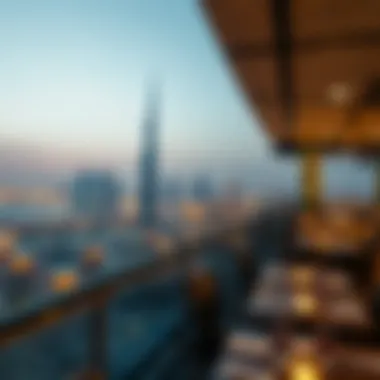
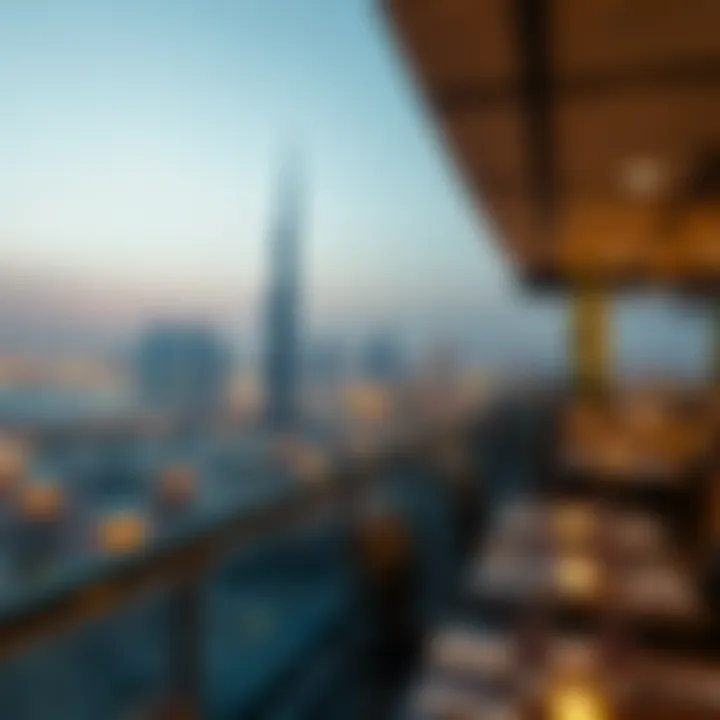
Intro
In the opulent landscape of Dubai, rooftop dining is not merely about sustenance; it's an experience that harmonizes culinary artistry with breathtaking views. As the city stretches vertically, the rise of sleek skyscrapers presents a tapestry for a dining culture that is vibrant and eclectic. Culinary delights served high above the bustling streets create a distinctive allure that attracts both locals and visitors alike.
Rooftop restaurants in Dubai serve as a microcosm of the city’s broader gastronomic scene. They punctuate a skyline filled with architectural wonders, from the iconic Burj Khalifa to the twisting form of the Cactus Tower. This article will take you on a journey, diving into the significance of rooftop dining in understanding the luxurious and ever-evolving tapestry of life in Dubai. We will explore notable dining establishments, their unique features, recommended dishes, and current trends that define this niche culinary landscape.
With every meal enjoyed against a backdrop of soaring towers and twinkling lights, the experience transcends mere satisfaction of hunger. It appeals to the senses, drawing people not just for the food but for the atmosphere that only a lofty vantage point can provide.
Let’s begin to unpack this epitome of modern dining and see what makes Dubai’s rooftop restaurants so special.
Foreword to Rooftop Dining
Exploring rooftop dining in Dubai takes us on a unique journey through culture, food, and the mesmerizing landscape of one of the world's most iconic cities. This exploration goes beyond just a meal; it reflects a lifestyle that combines culinary mastery with breathtaking views. Rooftop restaurants serve as modern-day terraces where visitors can savor gourmet dishes while gazing at the sprawling skyline of Dubai, making every meal an experience to remember.
The Concept of Rooftop Restaurants
Rooftop restaurants blend the culinary arts with architectural innovation, making them a standout feature in cities globally, but none as striking as Dubai. The notion of dining atop a skyscraper or an elevated platform adds an element of exclusivity, privilege, and adventure. Dining at such heights not only enhances the visual experience but also elevates the gastronomic journey. In Dubai, these venues often boast expansive views that stretch over landmarks, deserts, and the shimmering coastline, capitalizing on the city's verticality and luxury.
There is something inherently alluring about sipping a well-crafted cocktail or enjoying a beautifully plated meal while watching the sun set over the horizon or the twinkling city lights come alive. The atmosphere is often enhanced by carefully curated music, ambient lighting, and an overall ambiance designed to make each moment feel special. These restaurants cater to diverse tastes and preferences, attracting a clientele enamored with both culinary delights and remarkable vistas.
Cultural Relevance in Dubai
Rooftop dining holds a profound cultural significance in Dubai, which is a melting pot of traditions, flavors, and lifestyles. The city has been shaped by its history as a trade hub, and today reflects a confluence of global influences. As such, rooftop dining spots are not just about cuisine; they represent a social scene where people of different backgrounds gather to share experiences.
In a society that values luxury and innovation, Dubai's rooftop restaurants have quickly become a cornerstone of its vibrant culinary scene. They are popular among both tourists looking for new memorable experiences and locals who appreciate a high-end yet relaxed dining atmosphere. Notably, these venues often host cultural events and culinary showcases that celebrate international flavors, further bridging the gap between various communities.
"Rooftop dining in Dubai isn’t simply about food; it’s about connecting cultures and elevating the dining experience to new heights."
The rise of these spots aligns with Dubai's ambition as a global city, attracting investors and entrepreneurs in the culinary world. They reflect broader social trends towards outdoor dining and experiential eating, appealing to the increasing desire for unique, immersive experiences. Living in the fast lane, the citizens of Dubai savor these opportunities to unwind, reflect, and connect—all from a vantage point that most cities can only dream of.
Architectural Landscape
The architectural landscape of rooftop restaurants in Dubai is more than just an aesthetic consideration; it serves as a fundamental aspect of the overall dining experience. When one thinks of Dubai, the mind often wanders to its spectacular skyline filled with looming skyscrapers, each telling its own story through innovative design. The significance of this architectural backdrop plays a vital role in attracting diners looking for scenery that matches their culinary indulgence.
The carefully curated rooftop venues harmonize luxurious design with functionality. Open-air settings, elegant furnishings, and ambient lighting contribute not only to the visual feast but also create a sense of comfort and intimacy. This blend transforms the act of dining into a multi-sensory experience, where the sights and sounds of the city complement the flavors served on the plate.
Moreover, the layout of these restaurants often allows for extended views of Dubai’s iconic landmarks. This is pivotal, as it invites diners not just to eat, but to revel in a broader cultural context that reflects the city's vibrancy and diversity. The allure of a meal with a view can profoundly affect patron choices, turning an ordinary evening into a memorable affair.
While the competition among Dubai's finest rooftop establishments grows, each restaurant's architectural prowess becomes a distinguishing factor – an embodiment of what diners can expect before even setting foot inside. This convergence of functional design and striking visuals creates a unique selling proposition that is hard to ignore in a densely saturated market.
Skyline Views and Restaurant Design
Rooftop restaurants in Dubai boast stunning skyline views that elevate the dining scene. Take the likes of At.mosphere in the Burj Khalifa; it offers a panoramic perspective from one of the tallest buildings in the world. The design of these venues is often meticulously planned to maximize visibility. Large glass windows and smart engineering ensure unobstructed views, drawing patrons in like moths to a flame.
The design and layout of these spaces matter significantly. For example:
- Open Concepts: Many restaurants favor open layouts that invite the cool evening breeze and the vibrant life of the city underneath.
- Stylish Lounges: Catchy lounge areas with comfortable seating allow guests to savor both their meal and the gorgeous surroundings.
A focus on architectural aesthetics leads to diverse styles, from ultra-modern minimalist looks to elegantly ornate designs that reflect Dubai's rich cultural heritage.
Integration with Urban Architecture
The integration of rooftop restaurants with urban architecture is a testament to Dubai's continual evolution. Here, buildings aren't merely structures but part of a larger dialogue about space and usability. Rooftops can serve as vibrant social hubs that connect the community, offering a relaxing retreat above the urban hustle.
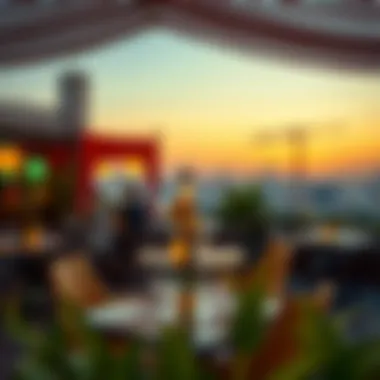

By harmonizing restaurant designs with existing buildings, designers pay homage to Dubai's identity while pushing boundaries. For instance, the Nammos Dubai integrates natural elements with luxury, reflecting a laid-back yet elegant lifestyle.
This careful orchestration not only enhances aesthetic appeal but also impacts sustainability efforts. Rooftop venues can contribute to urban greenery, utilizing vertical gardens or solar panels that serve dual purposes: leisure and efficiency. Such designs inspire a sense of responsibility towards the environment in high-density areas, encouraging a balance between development and conservation.
In summary, the architectural landscape crafted by rooftop restaurants in Dubai encapsulates both grandeur and sophistication. It's an intersection where culinary excellence meets outstanding design, creating spaces that are as captivating as the meals they serve.
Notable Rooftop Restaurants in Dubai
When it comes to dining experiences in Dubai, rooftop restaurants stand out as a significant part of the culinary landscape. Their appeal extends beyond just the food; they offer an extraordinary combination of scenic views, sophisticated ambiance, and diverse culinary offerings. In a city known for its towering skyscrapers and vibrant nightlife, these venues have carved out a niche that attracts both tourists and residents alike.
Rooftop dining is not just about eating; it is about creating memorable experiences. From the stunning sunsets that paint the skies to the breathtaking view of the city skyline, dining al fresco atop a chic restaurant can transform an ordinary meal into a celebration of life. Furthermore, these venues often host events, live music sessions, and offer curated cocktails, which add layers to the dining experience.
Establishing a notable rooftop restaurant in Dubai involves not only culinary excellence but also a well-thought-out design that complements the urban environment. Investors and restaurateurs must navigate regulations, aesthetics, and market trends to carve out their share in this competitive arena.
Overview of Popular Venues
In Dubai’s bustling dining scene, several rooftop restaurants consistently attract attention for their unique offerings and vibrant atmospheres. One such place is At.mosphere, located on the 122nd floor of the Burj Khalifa. Not only does it provide a stunning view of the city, but it also boasts a menu designed by renowned chefs that emphasizes gourmet cuisine, from fine cuts of meat to exquisite seafood.
Another gem is Cé LA VI, perched atop the iconic Address Sky View hotel. Here, guests can indulge in Asian-inspired dishes while taking in the panoramic views of the Dubai Fountain and the surrounding skyscrapers. Other notable venues include Zeta, known for its modern Asian fare, and Level 43, which presents a lively rooftop bar experience amidst the twinkling lights of the city.
These restaurants are not just culinary venues; they double as social hubs where people come together to unwind and enjoy the breathtaking scenery. The intermingling of locals and expatriates fosters a sense of community, enhancing the overall experience.
Comparative Analysis of Menus
Analyzing the menus of these rooftop restaurants reveals a striking diversity in culinary themes, presentation styles, and flavor profiles. For instance, At.mosphere offers a meticulously crafted menu that reflects its upscale market positioning. The dishes are often presented with artistic flair, using only the finest ingredients sourced from around the world.
On the other hand, Zeta combines classic Asian flavors with a contemporary twist, making it accessible to a broad audience while maintaining sophistication. The menu at Cé LA VI emphasizes fresh, seasonal ingredients while ensuring that every dish resonates with the essence of modern Asian cuisine, hence appealing to a young, cosmopolitan crowd.
Each restaurant plays into the trends of health and wellness as well, with more selections focusing on organic and locally-sourced ingredients. This move reflects a growing demand among diners who are increasingly conscientious about what they consume.
When comparing these diverse menus, it is evident that the culinary offerings are intentionally designed to cater to varying tastes. The integration of international flavors with local influences creates a unique fusion that is all but characteristic of Dubai’s dynamic dining scene.
"Dubai's rooftop dining experience is not just a meal, it’s an adventure in a skyhigh paradise, stirring your senses with every bite, and showcasing the city in its best light."
Exploring these notable venues offers insights into the broader culinary trends within the city. Investors looking to tap into the rooftop dining market must consider these nuances to ensure success and longevity in a competitive ecosystem.
Cuisine and Beverage Offerings
Rooftop dining in Dubai goes beyond mere elevation; it’s a blend of culinary art and breathtaking vistas. The offerings in these lofty venues are not just about food and drink; they are critical threads in the fabric of the overall dining experience. With the vibrant backdrop of Dubai's skyline, the food becomes part of a multi-sensory journey that captivates both locals and tourists alike. Let’s delve deeper into why the cuisine and beverage selections play a pivotal role in the rooftop restaurant scene.
The variety of offerings reflect the multicultural tapestry of Dubai itself. As such, one can savor not just local delicacies but also international flavors that echo the city's role as a global hub. This fusion elevates rooftop dining into a delightful exploration of tastes and techniques. You might enjoy a perfectly spiced shawarma while gazing at the Burj Khalifa or savoring sushi with the Gulf Sunset in the background. Furthermore, appealing beverage selections – from handcrafted cocktails to exquisite wines – complement the dining experience, enhancing the senses and enriching the moments shared.
Signature Dishes and Drinks
Signature dishes at rooftop restaurants often serve as a culinary signature of the venue. Chefs may create unqiue offerings that reflect their own interpretations of traditional dishes or introduce innovative options that surprise and delight. Take, for instance, the spiced lamb chops served with saffron-infused rice at a top-tier Dubai rooftop. Each bite is not just a flavor profile; it presents stories, heritage, and culinary mastery.
- Considered Pairings: Many restaurants offer recommended pairings of drinks with signature dishes, enhancing flavors and elevating the overall experience. A rich, smoky mezcal can perfectly accompany a zesty grilled fish, illustrating how thoughtful pairing can transform a meal.
- Theatrical Presentations: The way dishes are presented also draws customers in. For example, a dessert might be served with a captivating fire show, adding excitement. This theatrical flair captures attention and enhances the dining adventure.
Regional and International Influences
The culinary landscape in Dubai's rooftop dining scene is a microcosm of global influences, mirroring the city's status as a melting pot. The fusion of regional and international cuisines creates a mosaic of flavors, enticing even the most discerning palates.
- Local Flavors: Ingredients native to the region such as saffron, cardamom, and za'atar frequently star on menus, giving dishes a distinct Middle Eastern flair.
- Worldly Inspirations: On the other hand, you can find dishes inspired by Asian, European, and American culinary traditions. This openness to global influences allows chefs to get creative, oftentimes leading to fusion dishes like sushi burritos or truffle-infused hummus.
By combining the best of local and international cuisines, rooftop restaurants offer an experience that feels both familiar and exciting, allowing diners to embark on a culinary journey without ever leaving the restaurant.
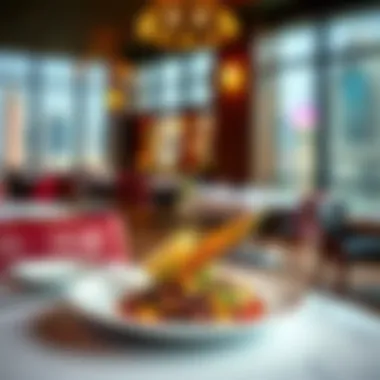
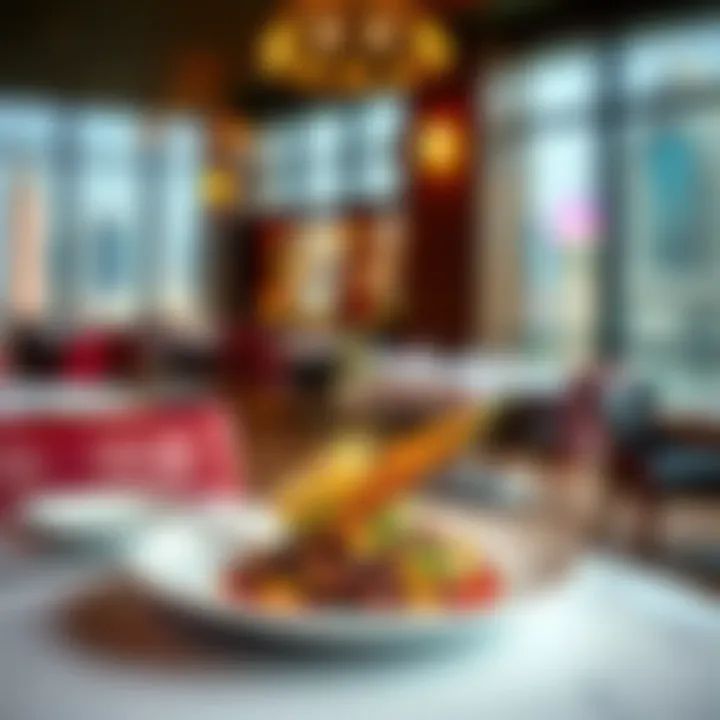
In summary, the culinary and beverage offerings at rooftop restaurants in Dubai are not simply a collection of dishes and drinks; they are integral components of a larger tapestry that defines the city's unique dining culture. They enrich the experience, making each visit memorable and worthwhile. From ’local tastes to global inspirations, the rooftop dining scene encapsulates a true celebration of culinary diversity.
The Dining Experience
The dining experience at rooftop restaurants in Dubai is not just about the food; it's a multi-faceted affair that combines taste, atmosphere, and service into an unforgettable memory. This narrative seeks to illuminate the significance of each element that goes into crafting the ideal dining outing for patrons, making it crucial for those looking to invest or participate in this segment of Dubai’s culinary scene.
Atmosphere and Ambiance
The atmosphere is the heartbeat of any dining establishment, but when it comes to rooftop venues, it takes on a unique flair. Picture this: high above the bustling streets of Dubai, diners find themselves surrounded by panoramic views that stretch across the skyline, with the sunset painting the sky in hues of orange and pink. The ambiance often reflects the cultural ethos of the city, with carefully curated decor that combines modern elegance with traditional elements.
Natural materials such as wood and stone are often used, providing a cozy yet chic atmosphere. Lighting plays a pivotal role too. Soft, artful lighting helps set the mood, allowing diners to immerse themselves in both the food and surroundings. Music tends to be subdued, adding another layer of sophistication without overwhelming conversation.
Importantly, outdoor seating also allows for an interaction with the elements. A gentle breeze can heighten the sensory experience, while heat lamps ensure comfort during cooler evenings. Rooftop settings often blend nature with urbanity, giving people a sense of tranquility amidst the city's hustle and bustle. This duality is appealing to both local clientele and international tourists craving an authentic experience.
Service Standards in Rooftop Venues
Service at rooftop restaurants is crucial, as it serves as the bridge that connects the exquisite culinary offerings to the overall experience. High service standards are not merely a box to tick; they are vital for creating lasting impressions. Staff is usually well-trained, knowledgeable about the menu, and skilled at making recommendations tailored to individual preferences.
A key aspect is the attentiveness of the staff, ensuring that guests feel valued and cared for without being intrusive. For instance, while ordering a high-end bottle of wine, the sommelier's expertise enhances the choice, as does their timely refilling of glasses, facilitating a seamless experience between courses.
Moreover, the ability to balance efficiency with personal touch elevates dining. A simple acknowledgment of a special occasion makes an average dinner extraordinary.
In addition, many rooftop venues incorporate technology to streamline service; think digital menus and mobile payment solutions that enhance guest experience. Overall, a combination of skilled staff, thoughtful service, and genuine warmth sets these establishments apart.
"The quality of service can elevate a good dining experience to a great one; it’s where hospitality meets culinary delight."
From the atmosphere that captivates to the smooth yet attentive service, every factor combines to outline why the dining experience at rooftop restaurants is worthy of exploration and investment. Whether it’s a romantic dinner or a vibrant gathering, the nuances of how a rooftop restaurant operates can significantly influence investors and developers considering entry into this market.
Market Trends in Rooftop Dining
Rooftop dining in Dubai has blossomed into a vibrant niche, reflecting not just the luxurious lifestyle of the city, but also its ever-evolving culinary culture. Understanding the market trends in this domain is crucial for investors, homeowners, and developers alike—as these trends can pave the way for future opportunities and ventures. The evolution in dining preferences, coupled with practical considerations for location and concept, influences not just current dining landscapes but also shapes the direction of future investments.
A closer look at consumer behavior reveals the factors driving rooftop dining's popularity. The unique offerings and experiences that these venues provide are significantly influencing market demand. Customers today are increasingly looking for more than just food; they desire an experience that marries ambiance with cuisine. This shift underscores the importance of creating environments that cater to the taste of adventure-seekers and connoisseurs alike.
Emerging Concepts in Cuisine
The culinary scene on these rooftops is where some of the most innovative concepts can be observed. Chefs are experimenting with novel flavors and presentations, intertwining local ingredients with international cuisines. For instance, a restaurant might offer Emirati dishes with a modern twist, such as saffron-infused pasta or date-based desserts garnished with edible flowers. Another trend is the incorporation of fusion concepts where Asian flavors meet Mediterranean ingredients.
Interestingly, plant-based menus are gaining traction as more patrons seek health-conscious options. Restaurants are embracing sustainability, sourcing ingredients from local farms, and emphasizing organic produce. This not only supports local economies but also resonates with consumers interested in responsible dining experiences.
"The blend of skyline views and culinary innovation creates a dining experience that is simply unmatched in Dubai.”
Popularity Among Demographics
As rooftop dining continues to rise in stature, it appeals to diverse demographics, including younger crowds, families, and expats. Social media plays a significant role in this popularity; patrons are drawn to venues with scenic vistas and aesthetically pleasing dishes that are Instagram-worthy. Young professionals, often on the lookout for trendy spots to socialize, are particularly keen on cocktail lounges positioned high above the city streets. Each generation carries its own expectations, which influences the thematic choices—be it rustic chic or opulent glamour.
Families often gravitate toward casual atmospheres with menus that cater to all ages, offering kid-friendly options without compromising on quality. Conversely, high-end venues attract a more affluent clientele, focusing on exclusivity and fine dining. The diversity in offerings ensures there’s something for everyone, strengthening the overall appeal and viability of rooftop establishments in perpetuating their growth in the market.
As these trends unfold, they herald an exciting future for rooftop dining in Dubai, ensuring that both diners and investors find value in this strikingly unique aspect of the city’s culinary landscape.
Investment Potential
The investment potential of rooftop restaurants in Dubai holds significant importance in understanding the overarching dynamics of this unique dining scene. With countless skyscrapers providing breathtaking views across the city, these establishments are not merely places to eat; they represent strategic ventures that blend real estate, hospitality, and enhanced consumer experiences. In this section, we will explore the multifaceted aspects of investing in rooftop dining spaces, considering their advantages, key elements, and financial implications.


Real Estate and Dining Ventures
One of the fundamental drivers behind the success of rooftop restaurants in Dubai is their connection to premier real estate locations. These venues often occupy prime spots atop high-end hotels or commercial complexes, which enhances their appeal. The interplay between real estate and dining ventures can create a symbiotic relationship, offering benefits that are hard to ignore:
- Stunning Locations: Rooftops provide unparalleled views, something that is undeniably marketable in a city known for its skyline.
- Luxury Brand Alignment: Associating with established real estate properties, particularly luxury hotels, elevates the restaurant's brand image and draws a high-spending clientele.
- Increased Foot Traffic: With the right marketing strategies, these venues can attract both tourists and locals, leading to steady patronage.
"The fusion of breathtaking views and innovative culinary experiences makes rooftop restaurants not just dining spots but sought-after destinations."
However, it’s not merely about location. Investors must conduct thorough market research and business assessments. Understanding the local dining trends, target demographics, and seasonal influences can help tailor offerings that resonate with the clientele. The insight of local market experts can be indispensable in navigating the complexities of this high-stakes venture.
Financial Considerations for Investors
Investing in rooftop restaurants necessitates a clear grasp of the financial landscape. To fully harness the potential rewards, one needs to consider several critical factors:
- Initial Investment and Setup Costs: Establishing a rooftop restaurant can be capital-intensive. High-quality interiors, commercial kitchen setups, and staff training demand significant upfront investment.
- Operational Costs: Managing a rooftop venue can entail higher ongoing costs, including maintenance of the space, staffing during peak hours, and weather-related challenges. Investors must consider seasonal fluctuations and the impact on the bottom line.
- Return on Investment (ROI): Evaluating potential returns should consider not just immediate profits but also long-term viabilities, like property appreciation or brand establishment.
- Licenses and Regulations: Investors must navigate through local laws and regulations specific to food and beverage service, especially related to rooftop venues, which may involve special permits.
By understanding these financial considerations, investors can make informed decisions that align with their business objectives while capitalizing on the unique opportunities presented by Dubai's rooftop dining market.
Investing in rooftop restaurants is not just about placing tables under the stars; it’s about integrating culinary innovation with the potential of valuable real estate, all while ensuring a memorable dining experience. This holistic view can drive successful ventures that contribute significantly to Dubai's vibrant culinary landscape.
Sustainability Practices
Sustainability in dining has taken a front seat in recent years, especially in a metropolis like Dubai, where innovation and luxury find their footing in a fast-growing urban landscape. Rooftop restaurants, apart from their stunning views and culinary allure, are increasingly recognizing their role in promoting sustainable practices. As more people look toward eco-conscious choices when engaging in culinary experiences, restaurants are finding ways to contribute positively to the environment while still delivering an unforgettable dining experience. This embraces not just the meals they serve, but the entire ethos of the establishment.
The importance of sustainability practices in Dubai's culinary scene can be traced back to several factors. First, there is an increasing awareness among diners about the environmental challenges that modern society faces. They want to align their dining choices with their values. Secondly, for investors and restauranteurs, adopting sustainable practices can lead to financial benefits, as eco-conscious consumers are often willing to pay a premium for dining experiences that reflect their values. Lastly, a commitment to sustainability can set a restaurant apart from its competitors, creating a unique selling point that draws in both local and tourist clientele.
Eco-Friendly Initiatives
More rooftop restaurants in Dubai are integrating eco-friendly initiatives into their operations. One predominant approach is utilizing solar panels to power their kitchens and lighting, harnessing the abundant sunshine the city enjoys. This not only reduces the carbon footprint but also lowers energy costs over time. Additionally, some venues are employing energy-efficient appliances which consume less electricity, contributing to a greener environment.
Notably, composting and recycling programs are gaining traction. They help in managing waste more effectively and reduce what ends up in landfills. Restaurants can work with local waste management companies to ensure that organic waste is composted, transforming it into nutrient-rich soil for community gardens.
"A sustainable dining experience is as much about the food on your plate as it is about leaving a lighter footprint on the earth."
In terms of sourcing, many rooftop venues are also looking closely at the materials they use. From biodegradable straws to recyclable packaging, these small changes can resonate significantly within the community and set an example for others.
Sourcing Locally and Responsibly
The sourcing of ingredients plays a pivotal role in sustainability practices. Many rooftop restaurants in Dubai are now prioritizing local sourcing for their produce, meats, and seafood. This not only supports local farmers and producers but drastically reduces the carbon emissions associated with transporting food from distant locations.
Restaurants may establish partnerships with local organic farms, ensuring they have access to fresh, seasonal, and minimally processed ingredients. This practice not only enhances the flavor profile of their dishes but also builds a stronger, more resilient local economy.
Diners are becoming more cognizant of where their food comes from; transparency is key. Restaurants that openly share their sourcing processes tend to attract a more informed and engaged clientele who appreciate the effort behind each meal.
Sourcing sustainably is not just about local ingredients, it’s also about ensuring that these products are raised and caught through ethical methods. Many rooftop establishments are choosing suppliers who adhere to practices that are kind to the environment and the animals. For instance, seafood sourced through sustainable fishing practices helps ensure that marine ecosystems are preserved for future generations.
In summary, sustainability practices in Dubai's rooftop dining scene reflect a deeper understanding of the connection between culinary excellence and environmental responsibility. As restaurants continue to evolve, both consumers and investors will likely see the benefits of supporting a sustainable culinary landscape that respects and preserves the unique environment of Dubai.
Epilogue
Rooftop dining in Dubai isn’t merely another trend; it represents a growing cultural icon, a fusion of gastronomy and awe-inspiring architecture. This article shines a spotlight on the transformative journey of Dubai's skyline dining, illustrating not only the breathtaking views but also the culinary innovations that come with it. With the backdrop of the city’s distinctive skyline, rooftop restaurants have become vital spots for social gatherings, business meetings, and romantic escapes—all while savouring diverse culinary offerings.
The importance of this conclusion lies in understanding that the future of rooftop restaurants in Dubai is bright and full of potential. As locals and tourists alike seek unique dining experiences, the focus shifts toward sustainability and authenticity. Visitors are looking for more than just a meal; they want a memorable experience that connects them to the local culture.
The Future of Rooftop Dining in Dubai
Peering into the future, what can we expect from rooftop restaurants in Dubai? A few key themes are shaping up:
- Sustainability: Many establishments are increasingly focusing on eco-friendly practices. From locally sourced ingredients to energy-efficient operations, this shift not only appeals to environmentally conscious diners but also positions restaurants as leaders in sustainable culinary practices.
- Cultural Fusion: Expect more restaurants to showcase not only local Emirati flavors but also blend international influences. This culinary melting pot can attract diverse crowds, making each dining experience unique.
- Technology Integration: The future will likely see a rise in tech-driven customer experiences. For instance, enhanced reservation systems, personalized dining experiences through apps, and even augmented reality menus could transform how diners interact with their meals.
- Enhanced Experiences: Rooftop dining is not just about the food anymore; it’s becoming an immersive experience with music, art, and themed nights that engage all the senses. Moreover, incorporating wellness elements like healthy menus and outdoor yoga sessions could appeal to health-conscious consumers.
"Rooftop dining in Dubai stands at the intersection of nature and luxury, paving a bright path for innovation and creativity."















